Kayaking is a fun pastime that offers a great way to connect with nature and get some exercise. However, figuring out how to transport two kayaks in a truck can be a challenge. Don’t let that deter you, though, because I’ve got the tips and tricks you’ll need to get those kayaks to the water without a hitch.
When it comes to transporting kayaks, there are a few things you’ll need to consider, such as the size of your truck and the type of gear you have. Safety should be your top priority, so it’s crucial to make sure your setup is secure before hitting the road.
In this article, we’ll go over different methods for achieving a secure and efficient setup that will let you transport two kayaks in your truck. We’ll discuss various options for carrying them, how to secure everything properly, and what additional equipment you might need. With the right approach, you’ll be enjoying time on the water in no time!
Contents
Contents
Evaluating Your Truck’s Carrying Capacity
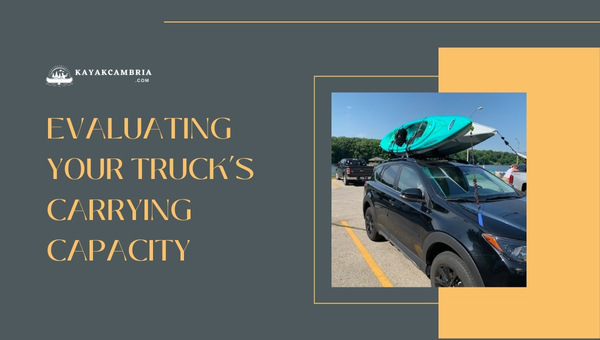
Before learning how to transport two kayaks in a truck, it’s important to evaluate your truck’s carrying capacity. You’ll need to know the maximum weight and size it can safely carry to ensure both the truck and the kayaks are protected during transport.
To begin, you should check your truck’s payload capacity. Payload capacity refers to the maximum weight your truck can safely carry, including passengers and cargo. You’ll find this information in your truck’s owner’s manual or on the manufacturer’s website.
If you’re wondering how much your kayaks weigh, it’s worth noting that the average weight of a kayak ranges from 30-70 pounds. However, some models can weigh over 100 pounds, so ensure you look for the exact weight in the product specifications of your kayaks.
Considering the weight of two kayaks and other accessories, such as the kayak rack and padding, it’s crucial not to exceed the payload capacity of your truck.
Calculate the combined weight of your kayaks, equipment, and passengers:
- Kayak 1: weight in pounds
- Kayak 2: weight in pounds
- Kayak rack: weight in pounds
- Padding: weight in pounds
- Passengers: total weight in pounds
Next, you must evaluate the available space in your truck bed. There is a variety of ways to transport kayaks, including using a truck bed extender, securing them to the top of a camper shell, and using a roof rack. Whichever method you choose, make sure it’ll safely accommodate the size of your kayaks.
Here are a few tips to help you evaluate your truck bed carrying capacity:
- Measure the internal dimensions of your truck bed or roof rack, including its length, width, and height.
- Compare these dimensions to the length and width of your kayaks to ensure a secure fit.
- Check if there’s enough clearance above the truck bed or roof rack for the kayaks to sit safely without interfering with essential safety controls, such as lights and mirrors.
- Ensure you have the appropriate tie-down points, usually located on the four corners of the truck bed or on the roof rack system.
- Invest in a quality kayak rack compatible with your truck’s make and model, providing proper support and safe transport of your kayaks.
Remember that safety should always be a priority when transporting kayaks. By thoroughly evaluating your truck’s carrying capacity and ensuring everything is safely secured, you’ll have peace of mind knowing you’re transporting your kayaks the right way.
Choosing the Right Kayak Rack for Your Truck
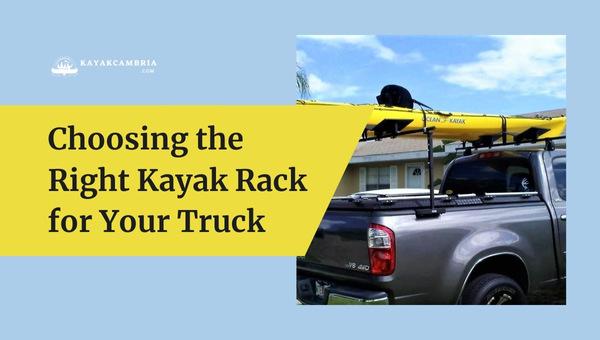
With many options available on the market, it’s essential to consider factors such as the type of kayak, the truck’s size and compatibility, and how secure and stable the rack is during transportation. This section will guide you through the important aspects you need to consider when selecting a suitable kayak rack for your truck.
First off, it’s essential to measure the dimensions of your kayaks and truck’s bed. Take note of the length, width, and height of your kayaks, as well as the truck bed’s width and length. This information will be helpful in determining what type of racks will fit and safely secure your kayaks.
Some popular options for kayak racks include:
- Ladder racks: Designed to hold multiple kayaks, ladder racks are adjustable and versatile. They provide a raised platform for the kayaks, allowing you to make use of the truck bed space below for additional gear.
- Truck bed extenders: These devices attach to the truck’s hitch and extend the bed’s length, providing support for longer kayaks that may hang out of the truck bed.
- Crossbar systems: Adding crossbars to your truck bed provides an elevated platform for securing kayaks. Crossbar systems often work with other attachments such as J-Cradles or stackers, which can help in holding the kayaks securely in place.
When assessing the type of rack that’s best for transporting two kayaks in your truck, some important factors to consider are:
- Compatibility with your truck model
- Ease of installation and removal
- Maximum weight capacity
- Security features such as locking mechanisms
Now, it’s crucial to research and compare racks from different brands that suit your specific needs. Some reputable brands to consider when shopping for a quality kayak rack include Thule, Yakima, and Malone. Additionally, reading customer reviews and testimonials can provide insight into the general customer satisfaction and reliability of various racks.
Transporting two kayaks in a truck requires a suitable, secure, and reliable kayak rack that matches your truck’s dimensions, your kayak’s size, and the specific features you need. Whether you opt for ladder racks, truck bed extenders, or crossbar systems, taking the time to research and invest in the right equipment will ensure a safe, enjoyable, and hassle-free kayaking adventure.
Preparing Your Truck for Kayak Transportation
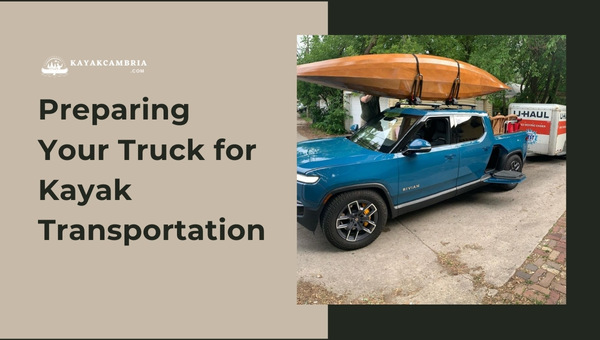
Transporting kayaks in a truck can be a bit challenging, especially when you need to carry more than one. In this section, I’ll outline how to transport two kayaks in a truck efficiently and safely by first preparing your truck.
The following steps are essential to ensure your truck is well-prepared for transporting your kayaks:
- Check your truck’s cargo area – Measure the dimensions of the cargo area to ensure your kayaks will fit. Remember to keep in mind any additional room needed for securing straps or padding.
- Assemble necessary equipment – You’ll need the following materials:
- A sturdy kayak rack or crossbars
- Ratchet straps or cam buckle straps
- Rope or bungee cords (for securing both ends of kayaks)
- Padding (such as foam blocks or pool noodles) to protect the boat and truck from scratches and dents
- Install the kayak rack or crossbars – If your truck doesn’t have a pre-installed kayak rack or crossbars, you’ll need to purchase and install one. They are essential for securely holding kayaks and ensuring their safety during transportation. I recommend a truck bed extender if you’re working with a shorter truck bed, as it adds extra support and space.
- Add padding – Laying foam blocks, pool noodles, or another padding onto the truck bed and kayak rack can minimize the risk of damaging your kayaks and truck. Secure the padding to prevent it from slipping during transport.
- Plan kayak placement – Before you load the kayaks, determine the best way to position both of them. A helpful tip is to place the heaviest kayak on the bottom and the lighter one on top. Double-check the weight and length capacity of your kayak rack or crossbars, as they can vary depending on your specific setup.
By following these steps, you’ll be well-prepared to transport your two kayaks in a truck. Proper preparation, secure placement, and ensuring you have the right equipment can make all the difference in a successful and safe kayak transport experience.
Proper Kayak Loading Techniques

To effectively transport two kayaks in a truck, it is essential to follow proper loading techniques. These techniques not only ensure the safety of your valuable kayaks but also prevent any damage to your truck or other vehicles on the road. In the following section, we will explore some basic techniques that will assist you in loading and transporting your kayaks.
Before diving into the actual loading process, let’s take a quick look at the necessary equipment:
- A truck bed extender or ladder rack
- Tie-down straps
- Foam padding or kayak cradles
- A tarp or cover to keep your kayaks cleaner
Now, let’s get into the step-by-step loading process for two kayaks in a truck:
- Prepare your truck: Make sure your truck is parked on a level surface and clear any debris from the bed. Extend the truck bed or install the ladder rack if required.
- Place the padding or cradles: Arrange the foam padding or kayak cradles in your truck bed or on the ladder rack evenly. This helps keep the kayaks from getting damaged during the journey.
- Load the first kayak: With the help of a friend or a kayak loader, lift the first kayak and carefully place it in the truck bed or on the ladder rack. Be sure it’s resting securely on the padding or cradles.
- Secure the first kayak: Use tie-down straps to secure the kayak to the truck bed or ladder rack. Be careful not to overtighten the straps, as it may damage the kayak’s hull.
- Load the second kayak: Repeat the process for the second kayak, making sure it’s placed safely and securely on the padding or cradles.
- Secure the second kayak: Use separate tie-down straps to secure the second kayak to the truck bed or ladder rack.
- Double-check your work: Give a final check to make sure your kayaks are secure, balanced, and tightly strapped down.
Some extra tips for successful kayak transport include:
- Be mindful of your truck’s payload capacity, as surpassing the limit could be dangerous while driving.
- If you’re using a truck bed extender, ensure it’s properly installed and secured.
- To avoid potential fines or obstructing other drivers, never let your kayaks extend too far from the back of the truck.
By following these proper kayak loading techniques and investing in the necessary equipment, transporting two kayaks in a truck becomes much easier and safer.
Securing the Kayaks with Straps and Ties
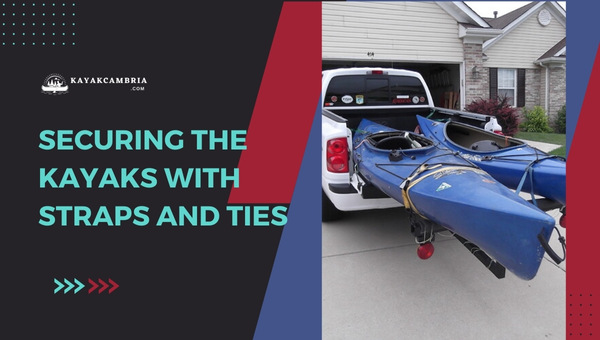
Properly securing the kayaks not only guarantees their safety but also minimizes the risk of damage during transportation In this section, I’ll discuss some important steps and tips for doing just that.
First off, make sure you have the necessary equipment for securing your kayaks. This typically includes:
- Ratchet straps or cam buckle straps: These are used to secure the kayaks to the truck and minimize movement during transport.
- Bow and stern lines: These help to stabilize the kayaks and keep them from shifting or tilting while on the road.
- Foam blocks or padding: This will provide extra protection and prevent any damage to the kayaks during transport.
Now that you have your supplies, follow these steps to properly secure the kayaks in your truck:
- Place the kayaks: Depending on your truck bed’s size and kayak dimensions, kayaks can be placed either side by side or on top of one another. Use foam blocks or padding to protect the kayaks and the truck bed from damage.
- Secure the kayak to the truck bed: Secure each kayak to the truck bed using ratchet straps or cam buckle straps. Loop the straps around the kayak and through the truck’s anchor points or tie-down loops. Ensure you don’t overtighten the straps, as this could damage the kayak.
- Attach bow and stern lines: Connect a line to the front of each kayak (the bow) and run it to the truck’s tow hooks or other sturdy attachment points. Repeat the process for the back of each kayak (the stern) securing the other end of the line to your truck’s rear. Ensure the lines are tight but not so tight as to deform the kayak.
- Check for stability: Ensure the kayaks are secure and stable by giving them a firm shake. If there’s too much movement, it could indicate the straps or lines are too loose, so make adjustments as needed.
By following these steps, you’ll ensure that your kayaks are secured safely and ready for transportation in your truck. Properly securing your kayaks not only keeps them protected but also keeps you and others on the road safe during the journey.
Transporting Kayaks Side-by-Side and Stacked
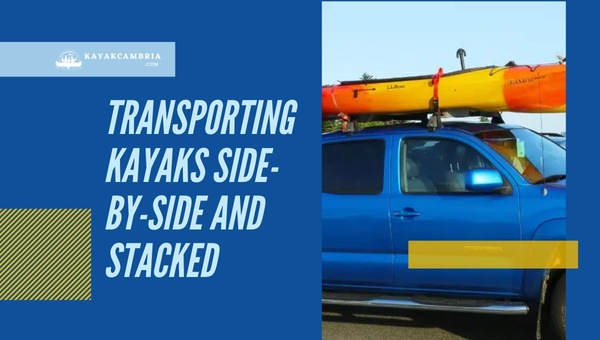
There are a couple of methods to transport two kayaks in a truck: side-by-side and stacked. Both methods offer their own advantages and should be chosen based on the size of your truck bed and the specific type of kayaks you own. In this section, I’ll explain the details of each technique, helping you decide the best way to secure your kayaks for transport.
Side-by-Side Method

For the side-by-side method, you’ll simply:
- Place both kayaks: Lay them flat in the bed of your truck, side-by-side, with the bow (front) facing the cab.
- Use padding: Make sure to include some padding (such as foam blocks) between the kayaks and the truck bed to prevent damage to either the kayaks or truck.
- Secure the kayaks: Use ratchet straps or ropes to tie them down tightly, ensuring minimal movement during transportation.
This method works best when:
- You have a larger truck bed with ample space for both kayaks.
- Your kayaks are relatively lightweight and easy to maneuver.
- Speed of loading and unloading is important to you, as it’s generally faster.
Stacked Method

For the stacked method, follow these steps:
- Place the first kayak: Lay one kayak flat, right-side-up, in the center of your truck bed.
- Add padding: Place padding (such as foam blocks, towels, or cut pool noodles) on top of the first kayak, focusing on areas where the second kayak will make direct contact.
- Stack the second kayak: Invert the second kayak and place it on top of the first kayak, aligning the hull and bow of both kayaks.
- Secure the kayaks: Use ratchet straps, ropes, or a bungee cord to secure the kayaks tightly to the truck bed, making sure they don’t shift or move during transport.
This method is ideal when:
- You have a smaller truck bed or limited space.
- Your kayaks are more substantial or harder to move, as stacking can save space and effort.
- You have the necessary padding and straps to safely secure both kayaks in a stacked position.
When using either method, ensure that you’re driving at slower speeds and taking turns gently, especially if the kayaks extend past the tailgate or if you’re using a roof rack.
Utilizing a Trailer for Multiple Kayaks
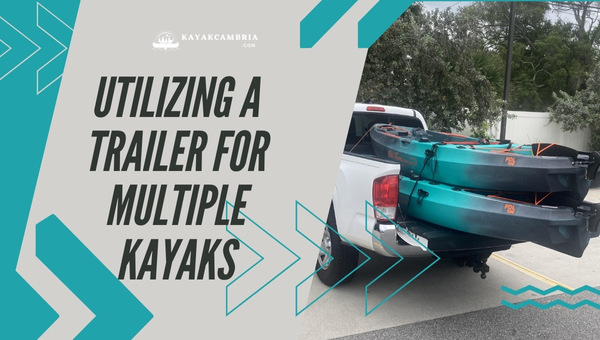
Utilizing a trailer can be an excellent option to transport two kayaks in a truck. I’ll walk you through a few benefits of using a trailer, as well as some practical tips to maximize efficiency and ensure the safe transportation of your kayaks.
One of the main advantages of using a trailer is that it provides an effective way to carry multiple kayaks without the need for a roof rack or bed extender. Trailers can typically hold 2 to 4 kayaks comfortably, depending on the size and design. You’ll want to start by selecting a kayak-specific trailer that offers padded bars and the ability to adjust the bars for different kayak sizes. A few popular choices include:
- Malone MicroSport
- Yakima Rack and Roll
- Ruff-Sport Trailer
When loading your kayaks onto the trailer, make sure to:
- Secure the kayaks properly:
- Place the kayaks on the padded bars with the bow facing forward
- Use multiple straps to fasten your kayaks securely to prevent any movement during transportation
- Tighten the straps in a crisscross pattern for added stability
- Check for towing requirements:
- Verify that your vehicle’s towing capacity can handle the combined weight of the kayaks and the trailer
- Ensure your truck has a proper hitch and electrical connection for the trailer lights.
Here are a few key benefits of using trailers to transport your kayaks:
- Reduced risk of damage: Trailers do not require lifting kayaks onto the roof of your vehicle, minimizing the risk of scratches or accidents.
- Easier loading and unloading: As trailers are closer to the ground, loading and unloading kayaks is simpler and requires less effort.
- Flexible storage space: A trailer allows for additional storage options if needed, such as installing cargo boxes, making it perfect for extended trips or multi-sport adventures.
Keep in mind that when driving with a kayak trailer, it’s essential to adapt your driving style accordingly, such as taking wider turns and allowing extra braking distance to avoid sudden stops. Finally, always take a moment to periodically inspect your kayaks, trailer, and straps during your trip to ensure everything remains secure and in place.
Using a trailer proves to be a practical and efficient solution when looking for a way to transport two or more kayaks in a truck.
Other Methods To Transport Two Kayaks in A Truck in 2025

Transporting two kayaks in your truck may seem like a daunting task, but with the right gear and a little know-how, it’s a breeze! In this section, we’ll outline five simple and effective methods to securely transport two kayaks using a pickup truck. So when it’s time for your next kayaking adventure, you’ll feel confident and prepared to hit the water.
1. Truck Bed

One of the simplest and most cost-effective ways to transport your kayaks is to place them directly in the truck bed itself. To do this, simply lay your kayaks side by side, with the hulls facing up. Next, secure them in place using ratchet straps or bungee cords to prevent any movement during transportation.
Keep in mind that this method works best for long truck beds or for those who have smaller kayaks. For added protection, place a foam block or soft pad between the kayaks to avoid any damage or scratches.
2. Kayak Rack Roof System

A kayak rack roof system is another convenient way to transport your kayaks. These systems typically consist of a set of crossbars that mount to your truck’s roof or truck bed rails. To secure the kayaks, place them on their sides on the crossbars, using kayak racks or J-cradles.
Once the kayaks are in place, fasten them with straps and ensure that they are sturdy and secure. This method offers the benefit of keeping the truckbed clear for additional storage and gear, and can easily be used to transport other sporting equipment as well.
3. Kayak Truck Rack

A specialized kayak truck rack is specifically designed for transporting kayaks in a pickup truck. These racks often feature multiple crossbars and kayak-holding systems to hold the kayaks securely in place. Some kayak truck racks can also be adjusted to transport additional equipment or gear.
To install and use the rack, attach it to the truck bed’s side rails, place the kayaks on the crossbars, and then secure them with straps or tie-downs.
4. Truck Utility Bed

If your truck has a utility bed with built-in storage compartments, you can take advantage of these spaces to efficiently transport your kayaks. Load the kayaks into the compartments and secure them in place using straps or bungee cords. The key advantage of this method is that it keeps your kayaks out of sight and protected them from potential theft.
5. Truck Bed Extender
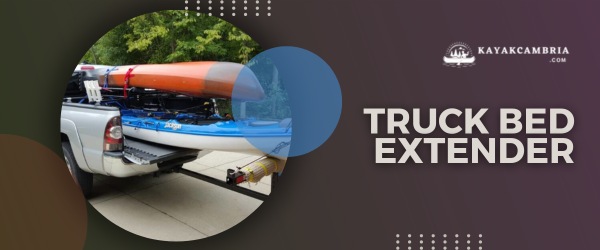
A truck bed extender is a great solution for those with shorter truck beds or longer kayaks. These extenders attach to the truck’s hitch receiver and effectively increase the length of your truck bed.
Start by placing the kayaks in the bed, with the sterns resting on the extender, and secure them with straps or bungee cords. Be sure to add reflective tape or flags to the exposed kayak ends so they’ll be visible to drivers following you.
How To Transport Two Kayaks Without a Roof Rack in 2025?
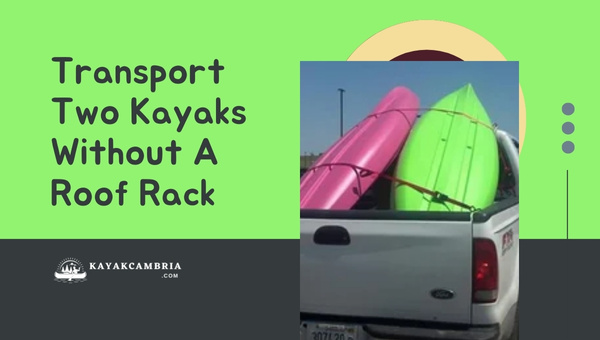
Kayaking is an exciting outdoor activity that allows you to explore gracefully through the water. So, you’ve got two kayaks and a truck – how do you transport them safely? The good news is there are numerous methods available, suitable for different budgets and preferences. In this article, we’ll discuss five safe ways to transport two kayaks in your truck without needing a roof rack.
1. Use a Utility Trailer

Using a utility trailer is one of the best ways to transport not just two kayaks but even more if needed. Trailers are designed for hauling various objects, including boats and recreational vehicles. You can easily attach one to your truck’s hitch receiver.
- Purchase or rent an appropriate-size utility trailer.
- Make sure the tailgate on your truck can be lowered or removed so that most of the weight will be on the trailer.
- Load both kayaks onto horizontal or J-shaped cradles.
- Install straps securely around each kayak and attach them properly.
Before hitting the road, perform regular safety checks including assessing proper tire pressure and checking that lights work correctly.
2. Your Truck

Owning a pickup truck makes transporting large items like kayaks relatively easy.
- Lower your tailgate and slide in both kayaks perpendicular to each other.
- Use sturdy straps such as cam buckle straps (Do NOT use ratchet straps)
- Tie-down points should include loops on each side of your bed
Remember: When using this method it’s worth noting that depending on state legislation, extra support as well as caution lighting may be required due to length restrictions so always check local guidelines!
3. Use Pool Noodles

If you don’t own any fishings gears then have no fear! Pool noodles offer versatile padding perfect for protecting paint jobs!
The process involves:
- Cutting pool noodles to fit the width of your truck.
- Inserting noodles under kayak edges in between the truck bed.
- Repeating this step at least twice more using other available cut-outs.
Tying down securely and periodically checking straps’ tension will ensure safe arrival to the destination.
4. Use Foam Blocks

Foam blocks are another affordable option for transporting kayaks on the bed of your truck. These cushioned forms will set underneath the kayaks and avoid damaging them or the vehicle. Ensure you use heavy-duty straps to safely secure them, attaching both ends over each kayak’s cockpit.
Law and Regulations for Transporting Two Kayaks in a Truck (2025)
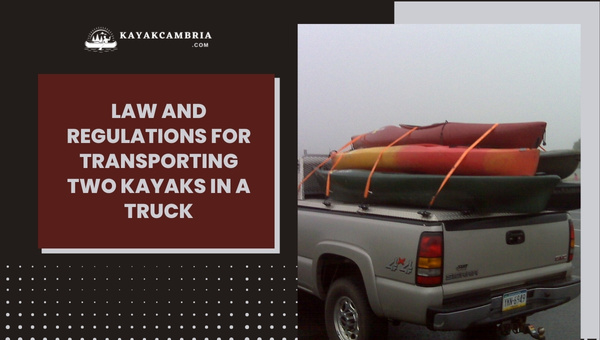
After knowing the methods of kayak transportation, it’s essential to be aware of the laws governing this process. Knowing these rules will not only save you from potential fines but also ensure that your journey remains safe:
1. Overhang
Ensure that your kayaks do not exceed any overhang limits set by local laws or regulations. Typically, the load overhang should not exceed one-third of the vehicle’s length for safety reasons.
2. Displaying Safety Flags (Red Flags)
In many states across America and other countries worldwide, it is mandatory to display red safety flags on any loads extending beyond 4 feet from the rear of the vehicle during daylight hours (orange at night). This makes it easier for other motorists to see and avoid potential hazards.
3. Unsecured Loads
Make sure that your load is well-secured using straps or ropes – failure to properly secure can result in hefty fines! All loose items should be tied down securely so they cannot shift during transport – posing both dangers to drivers around you as well disaster if anything were ever lost off back end while driving along highway speed limits with precious cargo!
4. Roof Rack Systems
Invest in a suitable roof rack system if you plan to transport two kayaks frequently. This can help avoid damage to your vehicle and provide a more secure attachment point.
Ensuring Safe Driving with Kayaks on Board

After loading up your kayaks, there are several essential steps to follow to ensure secure transportation and a safe drive.
Securing the kayaks is the first priority. To avoid any accidents or damage, make sure each kayak is tied down firmly. Using ratchet straps or cam buckle straps can make this process easier. Remember to check and double-check that the straps are tight and properly secured around the kayaks.
A secure connection from the kayak to the truck bed is another vital concern. It’s important to use paddings, such as foam blocks or pool noodles, to cushion any contact points between the truck and the kayaks. Proper padding prevents both damages to your equipment and possible accidents caused by shifting kayaks.
Additionally, consider securing the bow and stern of each kayak with separate tie-downs. These extra straps not only stabilize the kayaks but also act as an insurance policy if any other straps fail during transit.
Driving while transporting two kayaks in a truck requires extra attention and discipline. To help maintain safe driving, follow these guidelines:
- Drive at a moderate speed: Reducing your speed lowers the chances of your kayaks shifting or becoming unsecured during transport. It also allows for better control of your vehicle on the road.
- Avoid sudden movements: When changing lanes, turning, or stopping, do so smoothly and in a controlled manner. Sudden movements can increase the risk of your kayaks shifting or becoming loose.
- Increase following distance: Allow more space between your truck and the vehicle in front to ensure adequate time for braking and reacting to traffic conditions.
Finally, always remember to check on your kayaks at regular intervals during your journey. Make sure your straps, padding, and tie-downs remain secure and in place. Adjust as needed to minimize the risk of any accidents.
By paying attention to these details, you will ensure safe driving while transporting two kayaks in your truck. Keep these guidelines in mind, and you’ll be on your way to a stress-free, secure kayak transport experience.
Checking for Potential Problems During the Trip

It’s essential to be mindful of potential problems that may arise during your trip. I’ll go over some common issues to watch for and provide tips to help you avoid them.
One potential problem is kayak movement during transport. To prevent this, check the following:
- Ensure kayaks are properly secured with straps or ropes.
- Reconfirm the tightness of your tie-downs after driving for some distance, as they can loosen over time.
- Double-check that your load is balanced and won’t tip during transit.
Another concern when transporting two kayaks in a truck is damage to your vehicle. Take steps to protect both your kayaks and your truck:
- Place padding or foam blocks between the kayak and the truck bed to avoid scratches and dents.
- Use quality tie-downs and ratchet straps to secure the kayaks without causing damage.
- Avoid overloading your truck, as this may strain your suspension and possibly damage your vehicle.
Visibility should also be considered. Here are some tips to ensure a clear line of sight during your journey:
- Position the kayaks in a way that does not obstruct your view of the road.
- Make sure your rearview and side mirrors are properly adjusted for optimal visibility.
- Whenever possible, travel during daylight hours to have better visibility and avoid dazzling other road users.
Be prepared for any potential legal issues while on the road:
- Familiarize yourself with local transportation laws, as they vary by location.
- Check if a wide load permit is required for your specific situation, especially if your kayaks extend beyond the width of your truck.
- Attach proper flags or lights if your kayaks extend past the rear of your vehicle, making them visible to other drivers.
Finally, be mindful of the weather conditions and plan accordingly:
- Inspect the weather forecast before traveling, delaying your trip if necessary.
- Drive cautiously in wet or adverse conditions, as kayaks can catch the wind and create instability for your truck.
- Consider investing in a weatherproof cover for your kayaks to protect them from rain, snow, or debris.
By thoroughly checking for potential problems before and during your trip, you’ll increase the likelihood of a safe and enjoyable journey with your kayaks in tow.
Wrapping Up Your Kayak Transport Experience

Now that we’ve discussed how to transport two kayaks in a truck, let’s wrap up the experience. By following the correct methods, you’ll find it’s quite simple and safe to do so.
First, be sure to choose the right equipment and transportation method for your truck. Pick between kayak racks or bed extenders, depending on your preference and truck size. Always check:
- The payload capacity of your truck
- Size and type of kayaks
- Appropriate kayak rack or bed extender for your truck
Securing your kayaks is essential. Make sure to:
- Use high-quality straps or ropes
- Tighten the straps correctly
- Check straps for wear and tear
- Use the bow and stern tie-downs for added stability
Finally, don’t forget to prepare and inspect your truck before heading out. Perform a thorough check:
- Tires: condition and pressure
- Load capacity: don’t overload your truck
- Brakes: functioning and responsive
- Lights: all working and visible
Congratulations, you’ve now learned how to transport two kayaks in a truck. Adhering to these tips will not only help protect your kayaks but also ensure a safe and enjoyable trip to your favorite paddling spot. Now go on, load up your kayaks, and hit the road for your next adventure!

